Hanging out at Hangaroa Eco Village & Spa! Easter Island luxury hotels & resorts review, Rapa Nui.
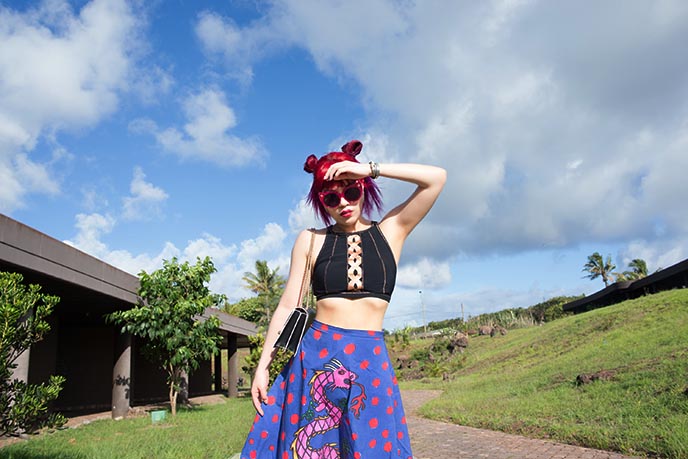
I haven’t yet made it to outer space… but Easter Island is as close as it gets to visiting an alien land!
I wanted to stay in a hotel that captured this interplanetary feeling, so I checked into Hangaroa Eco Village & Spa. If you’re looking for luxurious, culture-inspired lodging in the isle of the moai 🗿, then this is the place for you.

To my delight, even the rooms looked like spaceship pods!
OOTD: Dragon skirt by Print All Over Me, designed by gentlethrills. My Gottex halter bikini is from UK Swimwear.
My crossbody purse is this East/West by Strathberry. See more of their styles below:

While you don’t quite need a spaceship to arrive at Easter Island, this isn’t an easy destination to access. “Isla de Pascua” is located 2300 miles from Chile, in the middle of the ocean and surrounded by nothing.
There are only two flights here, from Bora Bora or Santiago, on LATAM Airlines. I flew from Chile’s capital city, and the trip took six hours each way. (But it was well worth it, to see the stone-faced moai… and what a view from the window!)

After a smooth flight, we landed at Mataveri International Airport. It’s one of the smallest airports I’ve ever been to — the runway spans the entire vertical distance of the island.
(All photography Joey Wong).

As soon as we stepped outside, we felt the hot weather of the South Pacific. I’m glad I brought sunscreen in my carry-on backpack (this is one of the best sunscreens, with UVA protection). My dyed and patterned undercut also helped me keep me from overheating.
My hair color, style and buzzcut are by Chad Mitchell Evans at Kore Salon Vancouver. Claw ring and earrings by Alex Streeter Jewelry.
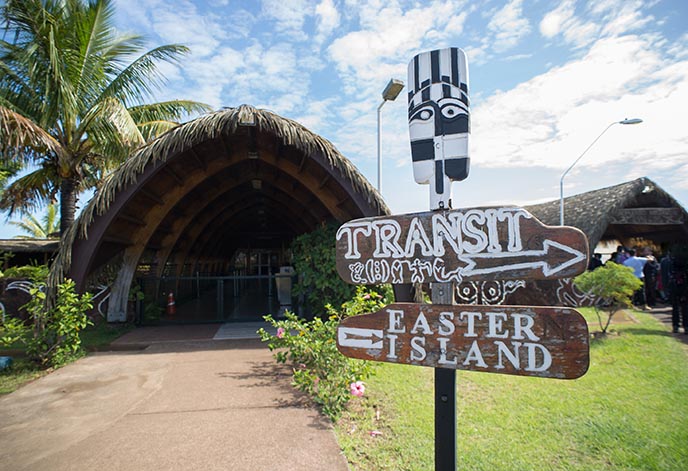
Disembarking is easy at Isla de Pascua airport… there’s only one counter and line. Be sure to purchase the $80 US National Park Ticket, or else you won’t be able to see the most impressive moai sites including Tongariki and Rano Raraku. You can purchase the park pass in USD or Chilean pesos (tip: check the current exchange rate to see which is cheaper).

Outside the airport, you’ll find staff members from various hotels and tour groups. We found the sign for Hangaroa Eco Village, and received a lei of flowers to wear around our necks, as well as a hearty “maeva!” (welcome!).
Easter Island is about the size of Manhattan, and our hotel is in the main city of Hanga Roa. It took only a 10-15 minute drive to reach these space-pods.

I was happy to kick back in one of best resorts in South America, according to Conde Nast Traveller.
The swimming pool beckoned, so I put on my Gottex Profile Sport DNA Bikini by UK Swimwear. I love the halter design, and rose gold on black accents. If you’re looking for the latest swimsuits and beachwear, there’s a fabulous selection on their website.
(See more of Gottex’s Gothic swimwear below, including laser cut Rococo styles):

The welcome wreath of flowers matched my pink hair and sunglasses. These glitter cat-eye sunglasses are by Irregular Choice. They create fabulous accessories and footwear, as you can see below…

Accessorizing with Easter Island nail art by Glam Nail Studio (close-ups further down), and silver critter rings by Alex Streeter.

Time to take a stroll around the hotel grounds. Established in 2012, Hangaroa Eco Village & Spa has the most luxurious accommodations on Easter Island. This five star resort features all-inclusive dining and one-per-day excursion packages, which take the stress out of planning.

The property is bursting with strange fruits and tall palms. From this convenient location, you can easily explore all the major sights on the island. (See my first post about my Easter Island moai tour).

Hangaroa Eco Resort’s architecture pays tribute to the village of Orongo (which I visited, as you can see here). The competitors of the birdman competition, Tangata Manu, lived in similar stone huts cut into the hillside.

The modern rooms let guests immerse themselves in the ancient Rapa Nui lifestyle. The design is inspired by traditional caves, with curving lines and organic materials including cypress wood and volcanic rock. I enjoyed soaking in the hand-made clay tub each day, and relaxing by the patio with an ocean view.

Love how this 75-room resort is integrated to its environment. Staying here, you feel as if you’re part of the culture and landscape of Easter Island.

Since I was in the land of the stone-faces, I got Easter Island gel nail art to match! Keiko Matsui, the brilliant nail artist and owner at Glam Nail Studio in Vancouver, drew these moai by hand with a tiny brush. She added sunset and galaxy backgrounds (since Easter Island may as well be in another dimension), gold and iridescent flakes, and metal oval rings.

Although most people come to Easter Island to see the moai, this is also a wonderful tropical destination for relaxing in warm weather. Guests can unwind at Hanga Roa Eco Village’s swimming pool and Manavai Spa, after a day of exploration.

Wearing a psychedelic gentlethrills skirt from Print All Over Me, and Goth bikini by Gottex from UK Swimwear.

In love with the clean lines and minimalist forms of Strathberry bags (this is mine). Find more of their purse designs below with a click:

Since Easter Island is basically in the middle of nowhere, it can be difficult to import foods, and restaurants tend to be expensive. Fortunately, Hangoroa Eco Village & Spa has several excellent dining options that can be included in the booking.
How fantastic is this ocean and mountain view? The open-air Poerava Restaurant offers a gourmet buffet at breakfast and dinner, with a wide selection of intercontinental and local specialties.

We filled up on grilled fish, creamy grits, roast vegetables, ceviche… and tried one of each dessert!

How cute is this moai, wearing a chef’s hat? On another evening, we ate at the resort’s Kaloa Bistro, where you can order South American dishes a-la-carte. Can’t go wrong with fresh empanadas, Chilean red wine and steak.

Every evening, Hangaroa Eco Village brings together guests for a free sunset cocktail at Vaikoa Bar. The special drink that evening was a pisco sour (lemon, Chilean clear brandy, egg white, bitters). I was delighted by the design of the liqueur bottle: it’s shaped like a moai with a “pukao” hat as the screw-on cap!

This is my happy place… sipping a moai pisco sour, and taking in the radiant sunset over the volcanic rocks and ocean.

Easter Island is such a remote and bizarre place that you can’t help but connect with the people you meet here. We made a furry new friend by the cliffs…

… and chatted with other travellers. Everyone expressed their amazement at being on this far-away island filled with mysteries.
The sunset silhouettes called for an “utthita hasta padangusthasana” yoga pose (extended hand-to-big-toe asana).

Easter Island is truly unlike anywhere else on the planet. Now, I think the only thing that can top this experience is a trip to space.

A tree-pose and namaste to Hangaroa Eco Village & Spa, for a stay filled with warm memories.

And a big thank you to LATAM Airlines for making this long-awaited trip possible. You can book a roundtrip to Rapa Nui with them, flying from either Bora Bora or Santiago.

Aren’t the stone-faced statues fabulous? For more about them, see my Easter Island moai photos here.
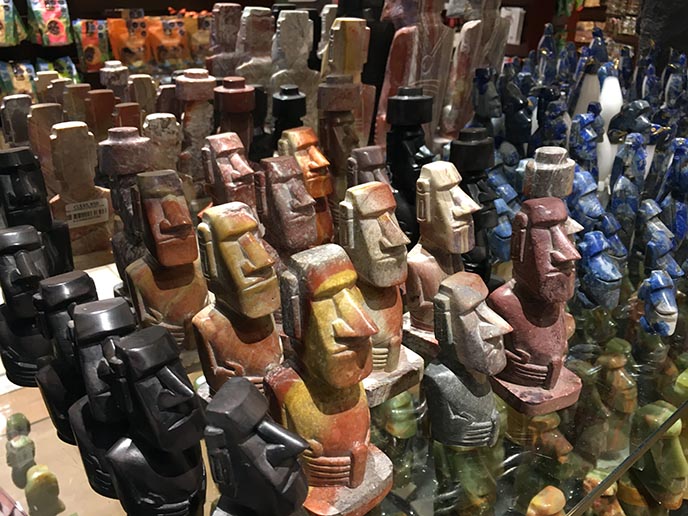
I never buy travel souvenirs, as I’m a minimalist… but I couldn’t resist getting some t-shirts and mini moais. This is a once-in-a-lifetime trip, after all.

I was tempted to take home the giant head… but I settled for a bottle of pisco alcohol, in the shape of a googly-eyed moai.
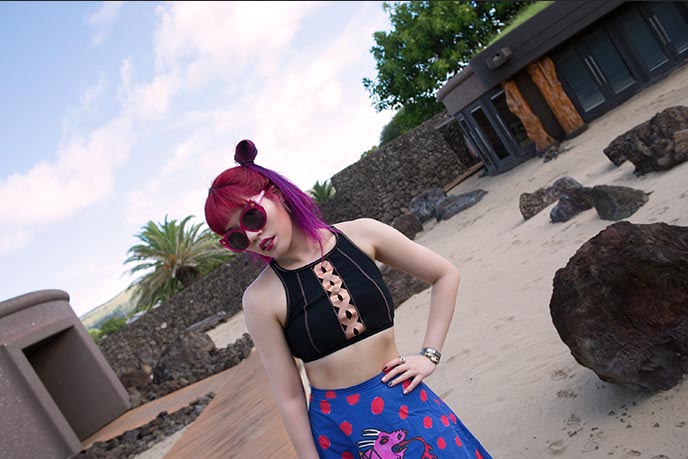
🗿 Isn’t Easter Island a fascinating destination? There’s still one more story to come, from two of the most famous UNESCO sites here… stay tuned.
(PS: see more Goth bikinis and one-piece swimsuits like mine below!)
SHARE & COMMENT
Goth Alternative Buenos Aires, Argentina! Recoleta Cemetery, Palermo street art, Eva Peron restaurant, La Cabrera.

Don’t cry for me, Argentina… The truth is, I had a spectacular time in Buenos Aires!
While exploring the South American city, I channeled Eva Peron’s style in a mid-century-style white dress. However, BA also has a hipster side, as you can see from the street art of the Palermo district.

Wouldn’t you like to see the coolest parts of Buenos Aires with me? Follow along as we dine at the Eva and Juan Peron themed restaurant, scout colorful murals, and indulge in steak and gelato.
(My ivory sweetheart dress is from Unique Vintage. Click the pics below for more of their gorgeous styles:)

And of course, this ghostly Goth paid a visit to Recoleta Cemetery — thanks to everyone who recommended the graveyard to me. Read on for Argentinian tales of the dead…. (All photography by Joey Wong.)

Buenos Aires is a beautiful city, with a European feeling: picture wide, tree-lined avenues and stately architecture. You can tell I was delighted to come to Argentina for the first time thanks to LATAM Airlines, which has many international flights to EZE (Ezeiza International Airport).
I’m wearing my new Alexander McQueen / McQ sunglasses from Sunglasses Shop. Love the tortoiseshell pattern on these chunky frames, which have a vintage feel that matches my outfit. If you’re looking for fabulous summer shades, Sunglasses Shop has tons of authentic, luxury glasses available at low prices on their site.

Buenos Aires is divided into various “barrios” or neighborhoods. One of the hippest barrios is Palermo, which consists of several sections: Hollywood, Soho and Viejo.
Spend time walking around Palermo, and you’ll run into cute boutiques, independent fashion, coffee shops, boutique hotels, bars… and lots of vibrant urban art.

Palermo’s rainbow backdrops were the perfect place to shoot outfit photos. I’m wearing this Unique Vintage 1950s champagne ivory swing dress, called the “Carole.” Inspired by 1950s style, this long champagne frock has an ivory lace overlay, and boned sweetheart bodice with spaghetti straps — and even side pockets!
Here’s another similar Unique Vintage white dress. Plus more styles from this retro-fashion brand below:

Argentina was once a wealthy Spanish colony, until its emancipation during the War of Independence (1810-18). Today, Buenos Aires remains a thriving cosmopolitan capital, nicknamed the “Paris of South America” for its world-class fashion, art and architecture.
(I spent the whole day walking around, so I paired my outfit with sparkly slip-on shoes.)

Buenos Aires is one of the most developed and easy-to-navigate cities in South America. Travellers love to come here to enjoy life to the fullest: tango dancing, leisurely meals, walks through elegant neighborhoods, and lots of red wine.

Close-up on my choker necklace by Reykjavik‘s Aurum by Guðbjörg. This Asterias design is inspired by the waves and natural forms of Iceland’s landscapes. I’m all about eye-catching jewelry that reminds me of my travels, so this is a personal favorite.

I paired my outfit with a headband and scarf from Tokyo, Japan (where I’ll be heading back soon). Always trying to be one of the birds and flying away…

A curtsy in front of one of my favorite murals, an eclectic collage by BA Paste Up.
The creative Palermo area is well worth a visit, for a peek at the youth / alt subcultures of Buenos Aires.

Now, for a darker destination… La Recoleta Cemetery, home to dramatic Gothic tombs. Don’t you love the Egyptian-looking one above?
Located in Buenos Aires’ Recoleta district, this famous graveyard is the final resting place of many notables, including Eva Perón, several presidents of Argentina, and Nobel Prize winners.
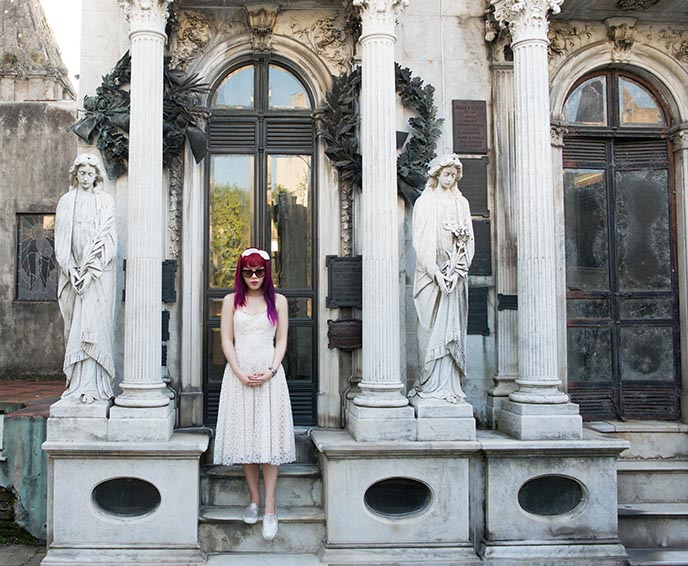
‘The woman in white” fit right in with these aristocratic mausoleums arranged in rows.
From these images, you can tell why Recoleta is considered one of the world’s most beautiful cemeteries.

Established in 1822, La Recoleta graveyard covers 14 acres. Many wealthy residents were buried here; their families put up elaborate marble mausoleums to “keep up with the Jones.” The architectural styles range (Art Deco, Art Nouveau, Baroque, Neo-Gothic), and the graves mostly are well-maintained.

These despairing angels, throwing themselves on the door of the dead… beautifully carved, and so Goth!

Arr, looks like a pirate be buried here. I was curious about these skulls and crossbones from 1875… but dead men tell no tales.

We arrived at Recoleta Cemetery as the sun was setting: the perfect golden hour for photos. Not long after, the custodian rang the bell to make sure everyone left before sundown… lest they be drained of blood by vampires, or something like that.
(Love how the top lace layer of my Unique Vintage dress captured the light. More designs from this retro vintage inspired designer below.)

We let the undead rest in peace, and walked on to our next destination…

… El Ateneo Grand Splendid bookstore. The name says it all: this is an exquisite 100-year-old theater that was converted into a book shop.
(On the right, do you see me up on the balcony, doing my best impression of Eva Peron giving her “final speech” to the people?)

Located in Barrio Norte, El Ateneo preserves the pomp of the former Grand Splendid Theater, which opened in 1919. The bookstore retains the gilded theatre booths, red velvet curtains over the stage, and Italian ceiling frescoes.

This venue has been at the heart of Buenos Aires’ entertainment industry over the years. In the earliest days, tango singers made recordings inside. The theatre became a cinema in the 1920s, and hosted the first “sound films” of Argentina. Today, the space is a wonderland for book lovers, and maintains the spirit of the Teatro Gran Splendid.

Buenos Aires’ food scene is also world-renown. The local specialty is, of course, Argentinian beef. Try the traditional “asado” or barbecue, or go to a “parrilla” (steakhouse) where the meat is cooked on metal grills by the same name.

I researched the best “parrillas” in Buenos Aires, and noticed that La Cabrera steakhouse had rave reviews. I arrived at the bright, rustic courtyard-style space in Palermo Viejo — and was greeted by the chef himself, Gastón Riveira!
Chef Riveira opened La Cabrera in 2003. Today, he’s celebrated for his outstanding menu that offers over 25 highest-quality cuts of beef, sides and Argentine wines. He’s now also a cookbook author and has three restaurant locations in BA, as well as in Paraguay, the Philippines, Dubai, Brazil and Peru.
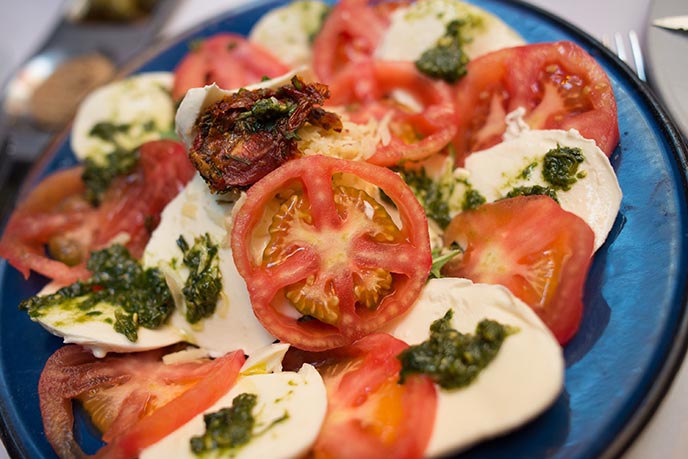
Our attentive server was great at explaining the various specials and cuts, and showed us a photo of the various “done-ness” to choose from. If you’re not big on meat, don’t worry — La Cabrera pays close attention to all its dishes, including vegetarian options and sides. We received a generous portion of caprese salad, with the freshest pesto, tomatoes and buffala. With a glass of local Malbec (red wine), it was the perfect start.

Here come the big guns. Tender short-ribs, and a spectacular Wagyu steak — one of the best in my lifetime so far. Many steakhouses overlook the side dishes, but not La Cabrera. The chimichurri green sauce, mustard and garlic dips, pureed squash, and mashed potatoes were total umami.
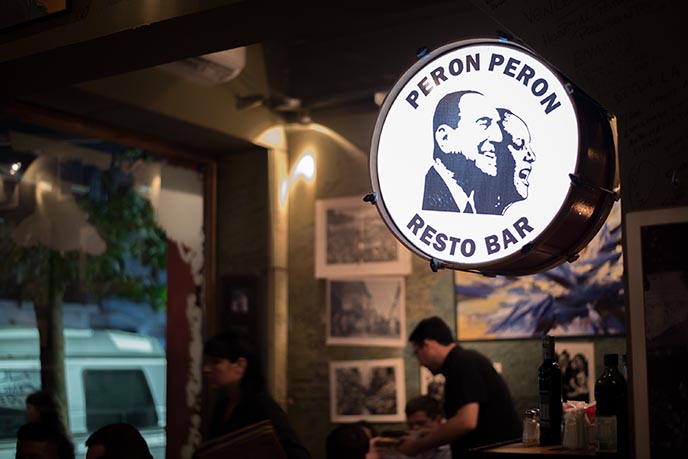
For another “only in Argentina” meal, make a reservation at Perón Perón resto bar (Address: Ángel Justiniano Carranza 2225, 1425 CABA, Argentina). This theme restaurant is dedicated to Juan Peron, President of Argentina three times in the mid-20th century, and his iconic wife Eva Peron — aka Evita.
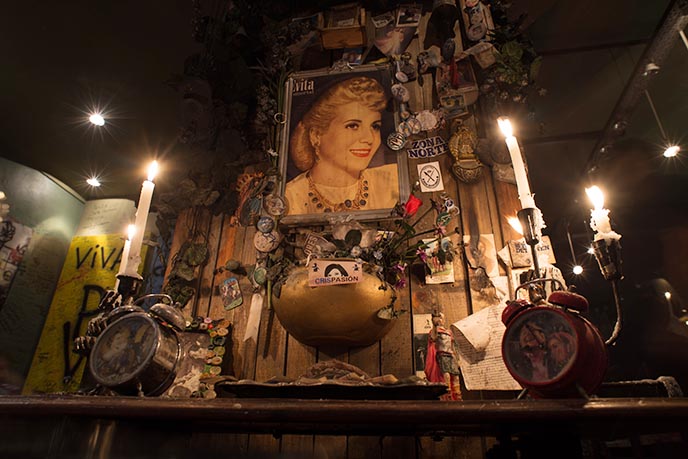
Try to reserve the special table, right in front of this shrine to Eva Peron! She smiled above us as we ate, surrounded by photos, candles, and vintage memorabilia.
Eva Duarte rose from poverty to fame as a stage, radio, and film actress. She married Colonel Juan Perón and became the First Lady of Argentina upon his presidency. “Evita” is beloved for her dedication to labor rights and women’s suffrage, and a foundation that helped low-income and working class Argentines. When she died from cervical cancer at age 33, Eva Perón received the title of “Spiritual Leader of the Nation” by the Argentine Congress.

The menu at Peron Peron captures the spirit of their politics, with cocktails named “We are the resistance” and “Nestor is alive” — a delicious mix of cynar, ginger syrup, angostura, fresh lemon juice and mint. (The name is a reference to Néstor Carlos Kirchner, President of Argentina in the 2000s with a Peronist ideology.)
We were feeling a bit “beefed out,” so we began with my beloved sardines, flavored with paprika and vegetables.
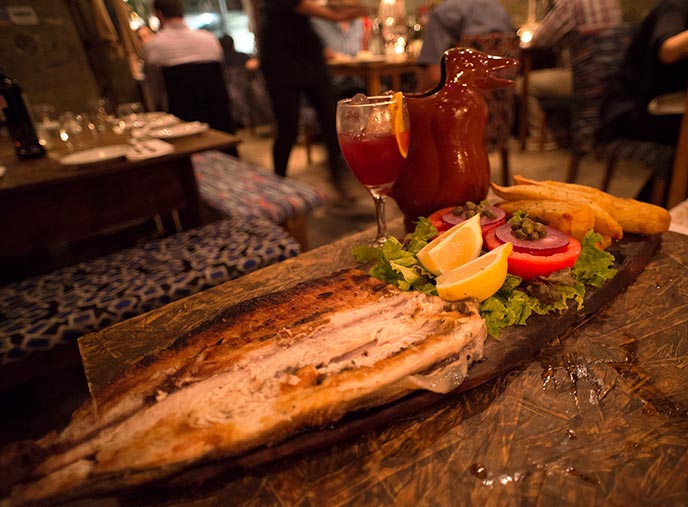
For the main, we had a large and juicy portion of South American pacu, a freshwater fish related to the piranha. This rustic “meal of the people” paired perfectly with red Sangria (ginger syrup, fruit and Justicialist Party wine). The drink came in a pinguino jar, which was popular among the working class in the 1920s and 30s, and inspired by the penguins of the Patagonia region.
The menu stated: General Peron said it loud and clear… “When one is hungry, no bread is stale.” At Peron Peron, however, everything was a fresh as could be.
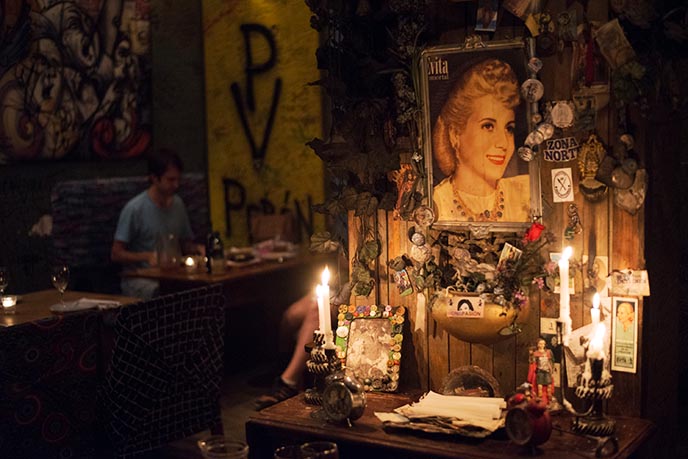
The restaurant isn’t a gimmicky tourist attraction — it’s a loving tribute to the Perons. All around, you can see paintings and photos: old headshots of Evita from her acting days, the couple waving from a parade car after winning the election.
Many groups of “Peronist” locals gather here to dine and chat politics. Twice a night, the restaurant broadcasts the “Marcha Peronista” song. Their supporters stand up, wave napkins around their heads, bang the tables and sing loudly to the refrain “Viva Peron!”

Stuffed and satisfied, I was glad to return to my Wimdu apartment rental. I had a superb stay in this local flat, which let me live like “one of the people” in Buenos Aires.
It was a breeze to book this apartment with Wimdu: the search engine pulled up available listings with photos and reviews, and this cute one caught my eye. I messaged with the owner, and easily picked up and returned the keys to the concierge at the lobby. I’m very glad I stayed here, as it was inexpensive and located centrally in San Telmo (I’ll show you stories from this district in the next post).
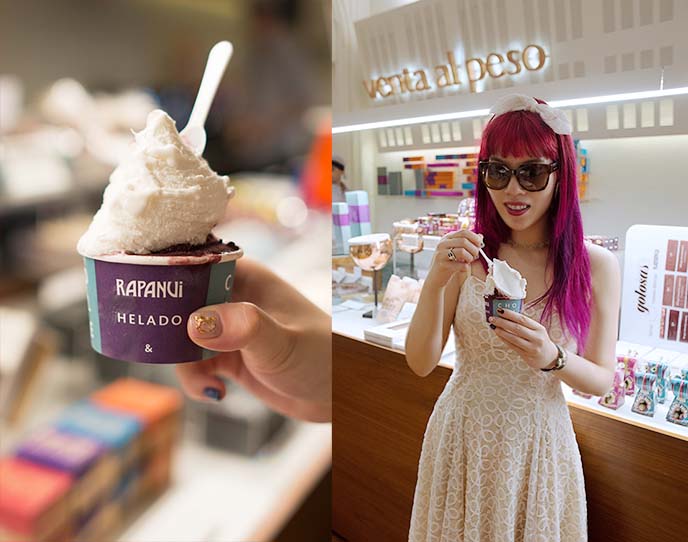
Let’s end on a sweet note, and a bonus food tip. Eat all the gelato, while you’re in Buenos Aires! The city is famous for its ice cream, which goes down especially well after a day of strolling under the sun. Locals told me one of the best gelaterias is Rapanui in Recoleta / Barrio Norte, and they were correct. I ordered a heavenly double scoop, and picked up dark chocolate to bring home as well.
Smile, there’s more to come soon from Argentina! Gracias LATAM Airlines for the flights here, and to Blacklane Limousines for the efficient airport transfers in a sleek black Mercedes SUV.
Have you visited the city of Evita? What are your impressions of Buenos Aires so far?



 LA CARMINA
LA CARMINA






